LA Times Feature “The Oaxacan-born cook caring for Yamaguchi Nursery’s historic bonsai collection”
August 5, 2023
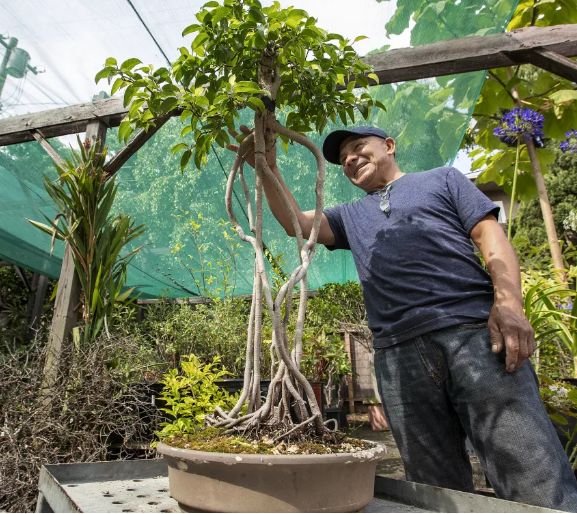
(Mel Melcon / Los Angeles Times)
For a few hours every afternoon, when the roar of the 405 Freeway becomes a murmur, Miguel Hernandez can hear the results of his work from the small shed at the edge of Yamaguchi Nursery on Sawtelle Boulevard.
A smile blooms on his face as a chorus of reverent whispers reaches his ears. “Wow!” “This is amazing.” “Look at this!”
The bonsai collection at Yamaguchi Nursery has some of the oldest and most valuable trees in Southern California, which is considered by some bonsai artists to be the art form’s mecca in America. Ever since founder George Yamaguchi died in 2005, Hernandez has cared for Yamaguchi’s creations as the nursery’s resident bonsai artist.
Bonsai wasn’t always accessible to people like Hernandez, who came to the U.S. from Oaxaca when he was 15. In Japan, a frenzied market for luxury horticulture produces big egos, obscene prices and a cloistered scene with formalized styles and methods.
But in the U.S., bonsai has always been the project of devoted hobbyists, and most of them are not Japanese. John Naka, known to enthusiasts as the godfather of American bonsai, eschewed competition and encouraged a focus on personal mastery. Along with Yamaguchi and other Japanese Americans such as Ben Oki and Harry Hirao, he traveled the country and taught anyone willing to put in the time and do the work.
John Y. Naka, 89; Brought Art of Asian Bonsai to the West
May 24, 2004
Although he refuses the term master and is reluctant to call himself an expert, Hernandez is the type of bonsai artist that only a place such as Los Angeles could produce. Four days a week, he works full time as a cook at Factor’s Famous Deli on Pico Boulevard, where he is the most senior employee. He also is an avid marathon runner and has competed in 26 races around the world, including the Boston Marathon.
At home, he cares for more than 600 of his own bonsai, and he is always making more.
“You build them up, and you watch it grow, and I don’t know,” Hernandez said. “It’s just amazing. You make this frame, and then Mother Nature fills it up. And some of them bloom, and they give you pleasure.”
Hernandez, 58, grew up helping his father grow corn, onions and tomatoes on their family farm in a small village in Oaxaca. Pleasure wasn’t part of what he learned. As a boy, he remembers his parents scolding him for planting a papaya tree in a pot because it would never bear fruit.
“But I didn’t want to eat it. I just liked the way it looked, there in the pot,” Hernandez said.
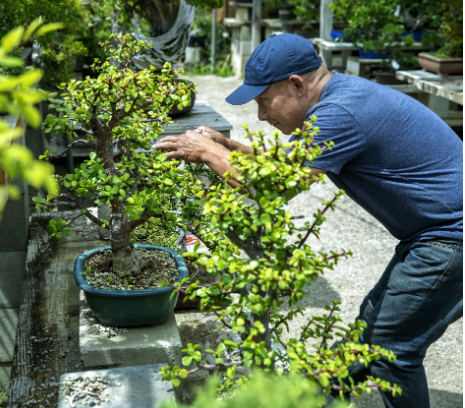
(Mel Melcon / Los Angeles Times)
In 1980, he came to the U.S. to find work and landed at Junior’s Delicatessen in Westwood. He used to walk by the nursery on his way home from work. He was so fascinated by the tiny trees that he began to spend hours peering over the fence and watching Yamaguchi work.
Yamaguchi was famously a man of few words. Robert Pressler, current president of the California Bonsai Society, says it took five years of visiting the nursery almost every week until the elder bonsai artist would address him with anything more than a grunt.
Yamaguchi taught a conservative and classical style, now considered old school, that emphasized the movement of a wild tree’s growth in nature. He specialized in black pines and yose ue, the forest style of bonsai that places several trees together in one pot.
Modern styles employ power tools and dramatic contortions, but Yamaguchi had a gentle touch. He believed each tree had a certain form that would unlock its potential, and the artist’s job was to manage that growth.
His most famous tree, collected in the National Bonsai Museum in D.C., is called Shinsei, meaning “voice of the gods.” The tree is a powerfully built, asymmetrical black pine whose branches flare boldly at the bottom, recalling how a tree might look if it stood alone in a meadow without competing with other trees for sunlight. The museum’s description calls the tree an example of the diversity of North American bonsai, which does not establish right or wrong ways to do bonsai.
His nursery, established in 1949, did much of its business supplying raw plant materials for landscaping businesses and home gardens. But Yamaguchi spent most of his time in the back with the bonsai. He seemed to prefer trees to humans. He would get mad at people if they let their bonsai die, said his daughter Marianne Yamaguchi.
Yamaguchi never named or trained a successor, Marianne said. But after Hernandez spent a few months of silent observation at a distance, Yamaguchi told the younger man to come to the nursery and start taking classes.
As Hernandez recalls it, Yamaguchi told him, “You’re not going to learn anything else by watching.”
Hernandez learned mostly by watching Yamaguchi and paying attention to how the bonsai artist would correct his trees. Hernandez’s first tree, purchased at a sale, was a juniper tree that died after a few months because he kept it indoors instead of outside where it belonged.
Yamaguchi taught him to fertilize the roots, wire the branches and read a tree’s movement and natural form. Hernandez’s work in the kitchen gave him quick, steady hands, and soon he realized that taking care of bonsai was as simple as following a recipe.
“It’s like a checklist, like in the morning you get up, you eat breakfast, you go running, you brush your teeth.”
Once he learned the trick of keeping trees alive, it was addicting. Soon he was driving hours into the desert to forage for naturally occurring bonsai trees. When his boss at the restaurant bought a property with an olive tree on it, Hernandez rescued the tree from the chainsaw and took about 100 clippings he is currently turning into bonsai.
His favorite kinds of trees have quirky, improvisational shapes and forms, like a ficus tree, severed at the trunk and supported by the exposed roots, like an octopus standing up on its tentacles.
At the nursery, under the green shade that protects the bonsai from the sun, Hernandez is quiet, but his hands are restless, pinching off buds and branches, poking to check the moisture of soil, inspecting the texture of bark and branch.
Some of his touches seem less functional and more like affectionate caresses for beloved pets, and a fond smile plays around his lips.
A smile blooms on his face as a chorus of reverent whispers reaches his ears. “Wow!” “This is amazing.” “Look at this!”
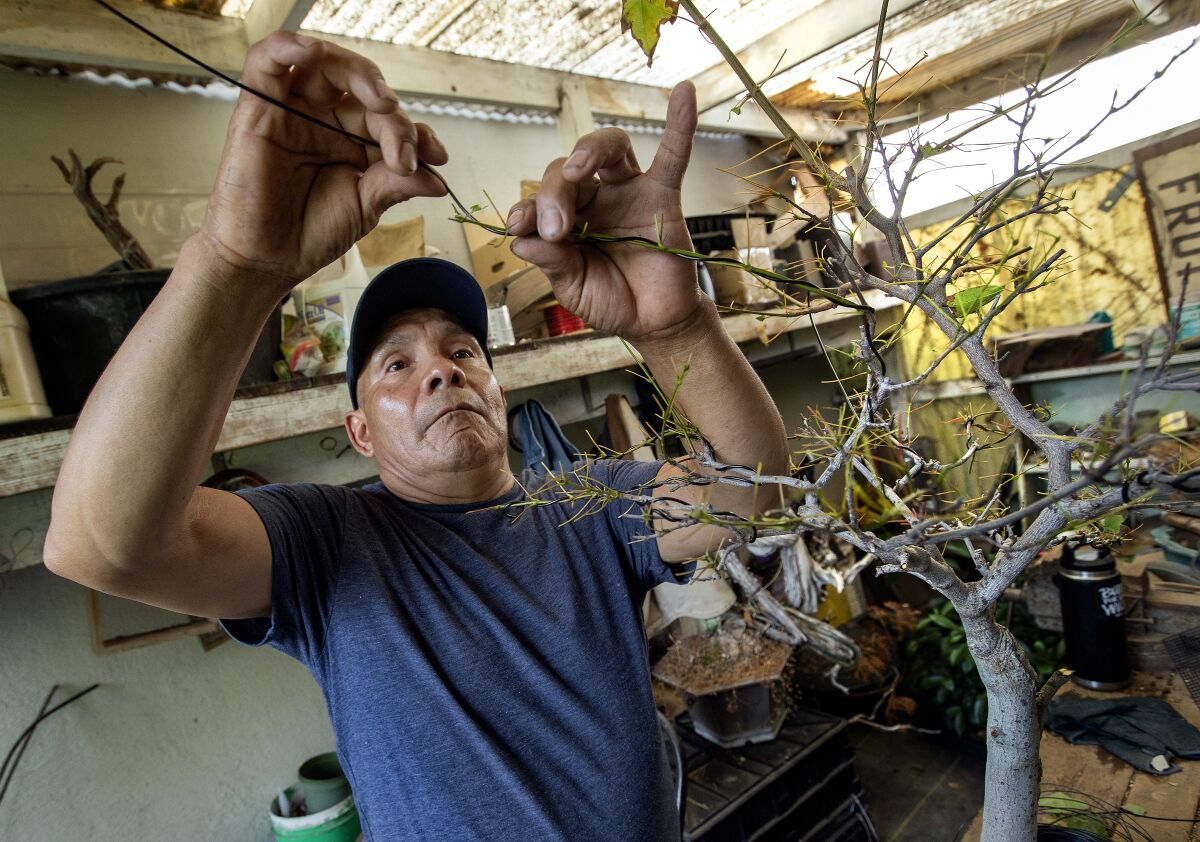
John Y. Naka, 89; Brought Art of Asian Bonsai to the West
May 24, 2004
Although he refuses the term master and is reluctant to call himself an expert, Hernandez is the type of bonsai artist that only a place such as Los Angeles could produce. Four days a week, he works full time as a cook at Factor’s Famous Deli on Pico Bouelvard, where he is the most senior employee. He also is an avid marathon runner and has competed in 26 races around the world, including the Boston Marathon.
At home, he cares for more than 600 of his own bonsai, and he is always making more.
“You build them up, and you watch it grow, and I don’t know,” Hernandez said. “It’s just amazing. You make this frame, and then Mother Nature fills it up. And some of them bloom, and they give you pleasure.”
::
Hernandez, 58, grew up helping his father grow corn, onions and tomatoes on their family farm in a small village in Oaxaca. Pleasure wasn’t part of what he learned. As a boy, he remembers his parents scolding him for planting a papaya tree in a pot because it would never bear fruit.
“But I didn’t want to eat it. I just liked the way it looked, there in the pot,” Hernandez said.

(Mel Melcon / Los Angeles Times)
In 1980, he came to the U.S. to find work and landed at Junior’s Delicatessen in Westwood. He used to walk by the nursery on his way home from work. He was so fascinated by the tiny trees that he began to spend hours peering over the fence and watching Yamaguchi work.
Yamaguchi was famously a man of few words. Robert Pressler, current president of the California Bonsai Society, says it took five years of visiting the nursery almost every week until the elder bonsai artist would address him with anything more than a grunt.
Yamaguchi taught a conservative and classical style, now considered old school, that emphasized the movement of a wild tree’s growth in nature. He specialized in black pines and yose ue, the forest style of bonsai that places several trees together in one pot.
Modern styles employ power tools and dramatic contortions, but Yamaguchi had a gentle touch. He believed each tree had a certain form that would unlock its potential, and the artist’s job was to manage that growth.
His most famous tree, collected in the National Bonsai Museum in D.C., is called Shinsei, meaning “voice of the gods.” The tree is a powerfully built, asymmetrical black pine whose branches flare boldly at the bottom, recalling how a tree might look if it stood alone in a meadow without competing with other trees for sunlight. The museum’s description calls the tree an example of the diversity of North American bonsai, which does not establish right or wrong ways to do bonsai.
His nursery, established in 1949, did much of its business supplying raw plant materials for landscaping businesses and home gardens. But Yamaguchi spent most of his time in the back with the bonsai. He seemed to prefer trees to humans. He would get mad at people if they let their bonsai die, said his daughter Marianne Yamaguchi.
Yamaguchi never named or trained a successor, Marianne said. But after Hernandez spent a few months of silent observation at a distance, Yamaguchi told the younger man to come to the nursery and start taking classes.
As Hernandez recalls it, Yamaguchi told him, “You’re not going to learn anything else by watching.”
Hernandez learned mostly by watching Yamaguchi and paying attention to how the bonsai artist would correct his trees. Hernandez’s first tree, purchased at a sale, was a juniper tree that died after a few months because he kept it indoors instead of outside where it belonged.
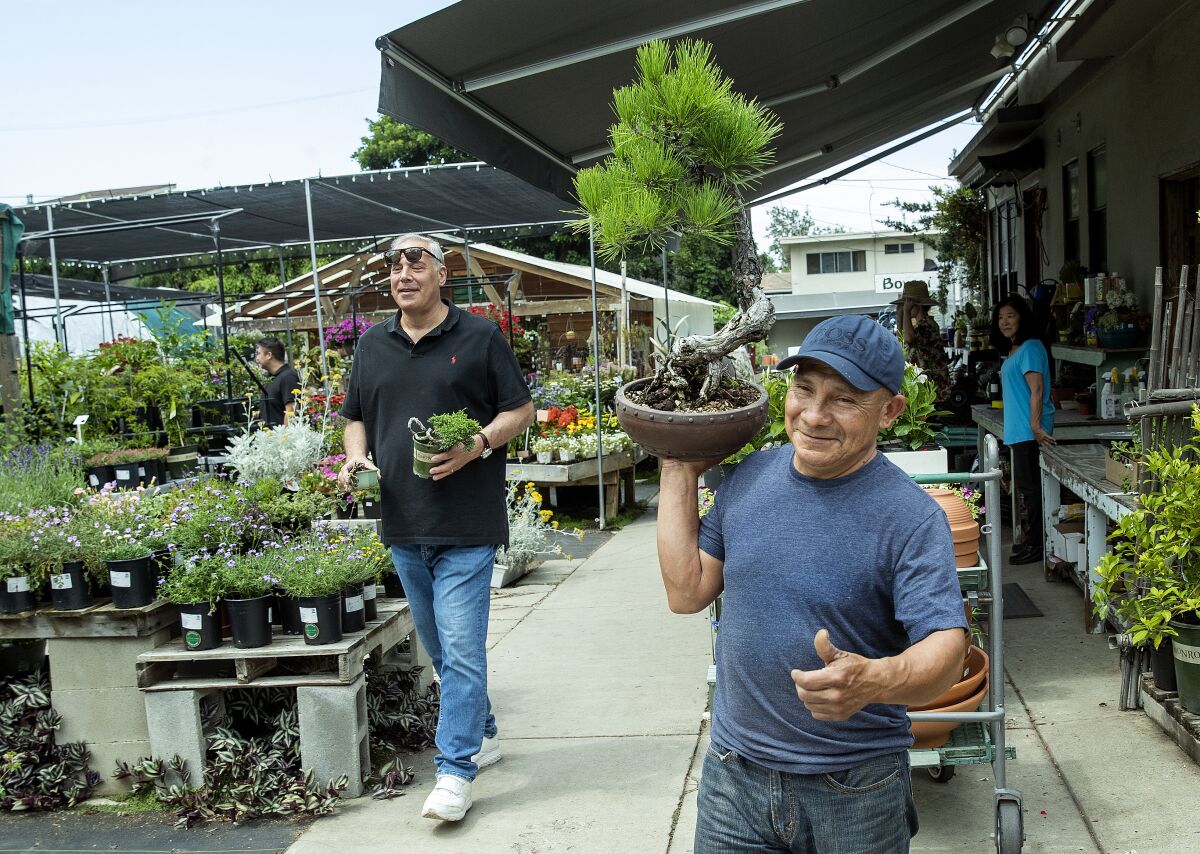
(Mel Melcon / Los Angeles Times)
Yamaguchi taught him to fertilize the roots, wire the branches and read a tree’s movement and natural form. Hernandez’s work in the kitchen gave him quick, steady hands, and soon he realized that taking care of bonsai was as simple as following a recipe.
“It’s like a checklist, like in the morning you get up, you eat breakfast, you go running, you brush your teeth.”
Once he learned the trick of keeping trees alive, it was addicting. Soon he was driving hours into the desert to forage for naturally occurring bonsai trees. When his boss at the restaurant bought a property with an olive tree on it, Hernandez rescued the tree from the chainsaw and took about 100 clippings he is currently turning into bonsai.
OUT AND ABOUT / YAMAGUCHI BONSAI NURSERY : A Yen for Miniature Trees
March 3, 1994
His favorite kinds of trees have quirky, improvisational shapes and forms, like a ficus tree, severed at the trunk and supported by the exposed roots, like an octopus standing up on its tentacles.
At the nursery, under the green shade that protects the bonsai from the sun, Hernandez is quiet, but his hands are restless, pinching off buds and branches, poking to check the moisture of soil, inspecting the texture of bark and branch.
Some of his touches seem less functional and more like affectionate caresses for beloved pets, and a fond smile plays around his lips.
::
Yamaguchi Nursery on Sawtelle, and its neighbor Hashimoto Nursery, are among the few surviving connections to the area’s agricultural history. In the 1900s, much of the area was farmland worked by Japanese Americans.
The neighborhood, which is the western-most Asian enclave in Los Angeles, was exempted from redlining in part because Westside homeowners treasured Japanese landscaping and wanted their gardeners to live nearby, according to “Sawtelle: West Los Angeles’s Japantown.” A large, endemic population of homeless veterans also made the land less desirable to white homeowners.
Now Yamaguchi Nursery is one of the largest properties on a street where buildings regularly change hands for tens of millions of dollars. The nurseries offer a peaceful green respite on a street that’s jammed most nights with locals drawn to the vibrant restaurant scene and nightlife.

(Mel Melcon / Los Angeles Times)
Marianne left her job in environmental management before helping to run the nursery. She’s not sure what the fate of the nursery will be, though she would like to keep it going. Her nephew, Kyle Lew, 30, is a talented bonsai artist who has worked on some of his grandfather’s trees. He also wants the nursery to remain open, but he isn’t sure of his plans yet either.
Interest in bonsai grew during the pandemic’s lockdown conditions, and overall, the industry is headed toward more competition and larger price tags. The most popular artists go to Japan to train, then offer courses online and in person at teaching nurseries. In Japan, the most expensive bonsai can sell for more than a million dollars, and even at private auctions in the U.S., prices are inching toward six figures.
Meanwhile, Hernandez comes in two days a week to keep the bonsai alive. He works at the same table where Yamaguchi once sat.
There’s a simplicity in his work that other artists say echoes that of Yamaguchi. Hernandez also aspires to mastery, but being around the trees is its own kind of joy for a man accustomed to the methodical pleasures of marathons.
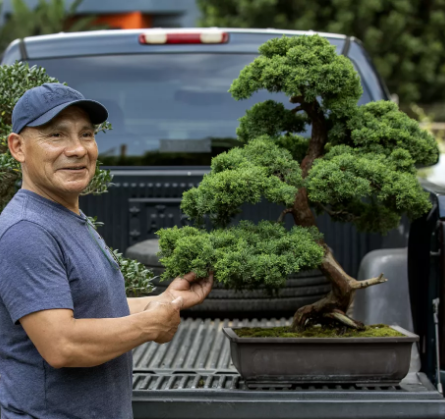
(Mel Melcon / Los Angeles Times)
More than anything, Hernandez sees himself as the caretaker of hundreds of tiny miracles. Each tree is like a parable of how life can be coaxed from the hardest conditions and what beauty can be found in that struggle.
“I don’t know why people say bonsai are always dying,” Hernandez said. “I always see them green. All green everywhere all the time.”
Robinson Garden’s Interview with Marianne Yamaguchi
May 14, 2021

To read the entire article, click HERE
June 15, 2011
Yamaguchi Bonsai Nursery – One of L.A.’s Best Kept Secrets
It is the weekend, and once again I find myself haunting my favorite nursery, for the fourth consecutive day this week. The quest for quality materials, unique plants and inspiration for my designs is an ongoing obsession for me.
As an advocate of shopping locally and supporting small businesses in my community, I discovered one of L.A.’s best kept secrets in town is Yamaguchi Bonsai Nursery, located on Sawtelle Boulevard in West Los Angeles. This second generation family owned business specializing in Bonsai, with complete nursery stocks, and oriental landscaping materials is a gem!
Established by George Yamaguchi in 1949, Yamaguchi Bonsai Nursery was first located on Sawtelle Blvd. and Olympic Blvd. Later in 1965, the nursery was moved and expanded to it’s current location at 1905 Sawtelle Blvd. In 2005, George Yamaguchi passed away and left an incredible legacy to his family, an established and community loved nursery along with his breathtaking private collection of Bonsai.
It is an honor to see Mr. Yamaguchi’s lifetime of work in Bonsai on display at the nursery in the Oriental landscaping materials area. There are many Bonsai from the Yamaguchi private collection.
The selection of landscaping materials available at this nursery is simply outstanding. Mrs. Yamaguchi and daughter, Marianne Yamaguchi are devoted to introducing unique, new, and forgotten varieties of plants to their inventory.
The Oriental landscaping selection of Japanese maples and Bonsai at Yamaguchi Bonsai Nursery is fabulous. The Australian and New Zealand assortment of grasses, bushes and shrubs are loved by inspired landscape designers. The drought tolerant California native flowering plants/ shrubs/trees collection is splendid. The much sought after classic topiary in globe, pyramid, cube, spiral, single and double poodle forms (in boxwood, juniper and wax leaf privet) are of excellent quality and affordable. The fruit tree and rose area is a feast for the eyes and senses. The wide variety of boldly colored blooming perennials and annuals will entice you to add a pop of color to your garden.
Love modern landscape design? The newly expanded pottery area, and a cactus /succulent section now dominating the rear of Yamaguchi Bonsai Nursery is totally worth exploring.
Looking for fragrant flowers? Their exquisite hybrid tea roses, gardenia and Burmese honeysuckle vine are perfect way to perfume any garden. Hybrid tea roses roses are available in a rainbow of colors: pale to hot pinks, purples, bold red, vibrant orange, sunshine yellow, and snow white.
Seeking a classical Mediterranean style garden? Brilliant geranium hanging baskets are all the rage this summer in fun colors: hot pink, lipstick red, coral orange, burgundy and white.
Want a more color? Bougainvillea is another great way to add color are used in both Spanish and Mediterranean landscape design. The attractive colorful flowers will add a romantic touch to any home. Available in candy purple, ruby red, pink, and sherbet orange. Australian Kangaroo Paw plant is also now in bloom. This lush green plant has a grass foliage base with tall 3-4 foot stocks and bloom soft velvet flowers, available in Indian yellow, rust orange and ox-blood red.
The selection of fruit trees, vegetables, salad greens, herbs, melons, and berries at Yamaguchi Bonsai Nursery is ever changing! The current inventory of summer tomato’s in black, purple, green, yellow, and deep red wine tones now available is simply tops! I particularly love this years late spring/ early summer selection of Japanese vegetables and herbs: Japanese kabocha squash, Kyoto amanga pepper, shishito Japanese pepper, Japanese long purple eggplant, green/ purple Shiso herb, soybean edamame, Natsu Suszumi Japanese cucumber, and spiny Japanese Suyo cucumber. Yummy!
Like it hot? Looking for hottest (scoville burn rating) peppers to grow this summer? Here are a few items that caught my eye: ‘Thai hot culinary peppers’ (five times hotter than a jalapeno), habenero (scoville rating of 3,000 plus) and the legendary hot ‘Fatilii pepper’ (scoville rating is 300,000).
Loyal customers, landscape designer’s and avid gardeners all appreciate being able to acquire superior quality plants, and hard to find items. Visit Yamaguchi Bonsai Nursery today, and see why this sanctuary of nature is so loved by everyone.
Tips For Shopping at Yamaguchi Bonsai Nursery
Plants at this nursery are healthy, beautiful and truly go fast! If you see something you love don’t hesitate to go for it! I recommend making a pile of your finds at the front area or on a cart. Kindly ask one of the knowledgeable nursery staff members to write you up for check out. If you need more of anything, you can have it special ordered at the front desk. A small parking lot is available, and there is plenty of metered street parking. Put plenty of change in the meter as you want to take your time strolling around.
Designer Summer Picks for a Vegetable Garden or Raised Bed Garden
Alpine strawberries (producing small sweet and aromatic wild berries spring – fall), lemon balm (great in hot tea),‘Paul Robeson’ black tomato (one of the most highly regarded of the black tomato varieties), ‘Purple Charokee’ tomato (legendary, juicy and delicious), red Italian dandelion (makes wild summer salads), Queen Anne’s pocket melon (small fruit with white flesh and extremely fragrant), and red or green mustard greens, Thai Basil, and ‘cymbopogon’ lemon grass.
Special thanks to Mrs. Yamaguchi, Marianne Yamaguchi, and all whole Yamaguchi Staff. I am grateful to you all for making my projects thrive and grow! Thank you for sharing your kindness, wisdom, and gardening tips with me over the years.
—Tara Feld, Landscape Designer (www.TaraFeldDesign)
 Best of LA
Best of LA
October 6, 2010
Yamaguchi Bonsai Nursery – Best Backyard Inspirations
The Japanese garden district on Sawtelle Boulevard in West Los Angeles features three nurseries side by side, companion planted, as it were, for mutual benefit. Of them, Yamaguchi Bonsai Nursery is the most artistic. As the name implies, bonsai is their specialty. But someone here has a keen eye for plant arrangements of all types — for the way in which dainty alyssum blossoms, say, complement a hefty profusion of petunias, mints and marjoram. Can a lowly house cactus inspire? It can here, jumbled into a pretty glazed clay pot with a squadron of weird little succulents.
The place feels like nothing so much as someone’s wonderful backyard. Everything in tight spaces. Life bursting out of every corner. Yamaguchi’s is a great place for wandering, and it helps that the plants are happy, fat and healthy. The abundance of beneficial insects — ladybugs, bees, lacewings — zipping about is a good sign, too. Sales ladies Michiko and Kate won’t mince words about which plants will thrive in shade and which require hours of blazing sun. Lest we forget, gardening is science as much as it is art. To some, it’s practically religion. If she’s in good humor (and detects that you have a sense of humor), Michiko may even offer to whisper a blessing over your newly purchased plants.
—Gendy Alimurung

